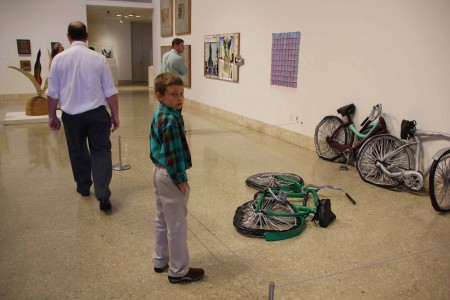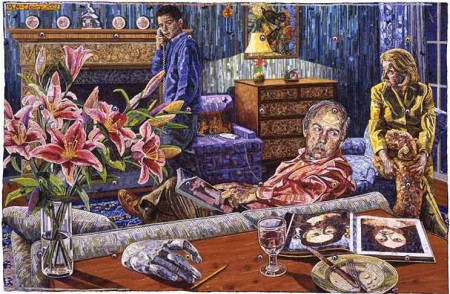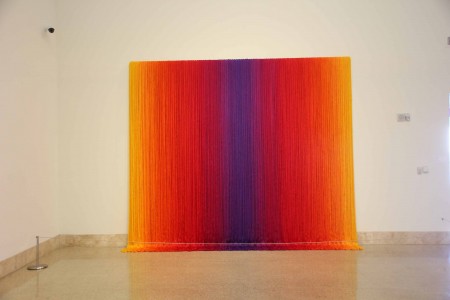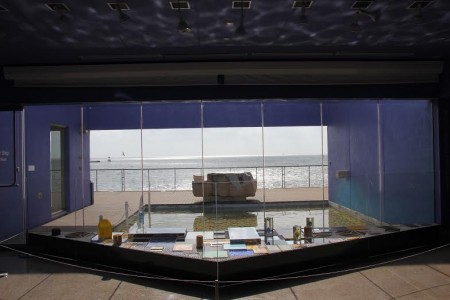Target: Texas—The Meanings of Mixed is exhibiting at the South Texas Museum of Art in Corpus Christi from the twelfth of May until the twenty-first of August. The show is a thoughtfully curated exposé on the nature of mixed media works soured entirely from the Lone Star State. The works featured are incredibly diverse and represent a vast network of resources used to generate a curatorial gaze of serious mileage. Texas, after all, is quite like a country of its own, and it’s “bigger than” attitude is evidenced by resourceful creative personalities such as those featured in Target: Texas—The Meanings of Mixed. An absolutely pristine catalogue was produced for the exhibition through the kind sponsorship of the Elizabeth Firestone Graham Foundation.
Deborah Fullerton Dunn, the Curator of exhibitions at the Art Museum of South Texas, used this exhibition as an avenue to display the aesthetic diversities of Texas artists working in the area of mixed media. The exhibition also works toward several other curatorial ends. The exhibition began in the early nineties under the curatorial direction of Maggie Gilliham. The initial focus was honed on just South Texas. The exhibition was reinstituted in 2008 and Fullerton thought it might be more interesting to draw on artists working in the area, while also reaching out to artist outliers in Texas, a state that really is like another country. The biennial nature of the exhibition allows for an initial idea to take shape gradually in steps. The material nature of the exhibition for this installation was rooted in the theme of mixed media which seems to have sprouted from Danny O’Dowdy’s works in the permanent collection, which Fullerton is familiar with having also been the registrar for six years now. The exhibition is exciting because of what it brings to Corpus Christi. It ultimately functions as a conversation of contemporaneity within the behemoth state of Texas, a place where art is thriving contrary perhaps to popular belief. It brings a thoughtfully selected sampling of contemporary Texan art to Corpus Christi where such strange birds might not otherwise land.[1] The exhibition becomes a celebration of Texas and seeing as Corpus Christi is a beach vacation hot spot for many residents of the state, this works out really well. Finally Fullerton explained to me that the most exciting part of this exhibition for her is being able to select artist that speak through materials as if materiality were a verbal tongue of emotion. This observable quality is powerful and provides an experience for the viewer that is truly moving. I would absolutely attest to this.
The exhibition features the work of seven artists. Danny O’Dowdy represents Corpus Christi well, having been a printmaking professor at Texas A&M University, Corpus Christi, in the past his inquisitive attitude toward material and narrative processes is wonderfully human. His approach to material is hard to quantify as each decision would seem derived of the situational and rooted in the subjectivity of the fleeting moment. The works presented feature freestanding wooden sculpture, painting, drawing, text, poured concrete, and found object. The resistance against singularity is palpable and recalls Rauschenberg’s “combines,” but also is concerned with object and narrative. Stories are told and yet completely generated by the mind of the viewer. Nothing is so terribly spelled out, and yet there is a space for notions, and a certain complete idea that’s up in the air, but bleeding the honey of satisfaction.
Margarita Cabrera’s sewn facsimiles of objects are extremely approachable as theirs is the surface of novel joy embroidered with the salt of scathing institutional critique. Cabrera hails from El Paso.The floor of the gallery is strewn about with a few of Cabrera’s hand sewn bicycles, floppy and blameless. The object’s are façade without function, like unloved prototypes never realized, there is an interrogation of industry wherein its quantifiable benefit is questioned. These objects are transfixed in limbo between the ephemeral and its materiality. This is perhaps most true of the toy-sized Hummer’s that are exhibited. For those that do not read Cabrera’s societal critique she has provided the novel and uncanny in abundance that observes a smiling befuddlement in gallery goers. There are two of Cabrera’s quilts included in this exhibition. On and Off Quilt was my personal favorite of the two. It kind of resembles a blanket of hairy nipples. The title implies numerous meanings, and as no quality of object is readily ascertainable the quilts provide a beautiful counter to the other works in the exhibition.
Mary McCleary’s incredible collaged paintings are perhaps the best represented with more than ten squirming surfaces asserting themselves along the entirety of the gallery’s second largest wall. Her paintings are collages of terribly specific objects innumerable in material personality and functional conscription. Flirting with kitsch and compulsion McCleary represents the cinematic and poetic while also formally sensationalizing her surfaces through material and depth. She is wooing the manic, with all the Romance of William Blake her surfaces percolate with the frenetic gurgle of coffee and mental gasolines. Collage becomes painterly through a coupling of the scientific complexity of Georges Seurat’s divisionism and the aesthetic lens of an overcrowded flea market replete with knick knackery and tiny fetish commodity. Her figures are swum through by the meticulously curated detritus that photographically describes their every feature. Moments of tension cinematically staged in the American domicile, a family vacation’s cozy-quiet observance of ski lifts from the cafeteria lounge, legends of the American West, the sex appeal of cigarettes, and moments of pure exaltation are rattling with the strange vocabulary of Americana gift shops talking through the decades. Finally, there is something cinematic about her collages that reference an Alfred Hitchcock-ian sensitivity of sensibility in translating visual movement. One might find a certain voyeurism of lens that is both cinematic and tactile procreating an atmosphere of endless human observance vis-à-vis banality and over abundance.
Gabriel Dawe’s work is composed entirely of vividly colored polyester threads that are arranged and displayed in manners both scrambled and perfectionist. The precision of science and geometry is present alongside structured surplus. The main focus of Dawe’s selection is an installation on the back wall comprised of thousands of threads arranged to describe a perfect and enveloping gradient transition of color from the sheer yellow of daybreak, into the somber purple reclining of twilight. The work is absolutely hypnotic and joyfully exuberant creating a palpable warmth of two dimensional visual enclosure. The installation is accompanied, perhaps somewhat less importantly, by several thread sculptures that experiment with the literal enclosure of structure in framed painting, fiberglass cubes, and the constriction of zip ties. There are also two meticulous color drawings concerned with geometrical arrangement and colored thread. The drawings presumably describe much larger installations. All of Dawe’s work is shouting with the resounding joys of the color and light spectrum.
Margo Sawyer is a sculpture professor at the University of Texas in Austin. Her installation interfaces with the gallery’s large window along the back wall that overlooks the bay, which is frequently busy with the coming and going of freighters and other vessels. It includes many different elements an surfaces including shiny ball bearings, panels of hand blown glass, polished metal, wood, and gold leafing. The objects and surfaces are corralled by a triangular pedestal that provides an effective harnessing of the ethereal smorgasbord of tactile elements that shine and reflect light through a myriad of delicate textural qualities. Her work describes the architecture of divinity through beatific surface and material. The incorporation of many different materials, explored through different processes investigate a creative ritual rooted in the tangible and suspended in a supernal ether.
Randall Reid, of San Marcos, deals with found object, the circulation of memory, and the patina of time. For Reid it would seem memory is writhing in the surfaces of old printed boxes, uncut sheets of rusted eveready batteries, forgotten toys, rulers, recycled painted and aged wood and steel. The evidence of chronological progressions are offset by variously recessed tiers and hierarchies of orientation. The weathered surfaces of Reid’s surfaces provide an associative substrate where the viewer may relate the past. Reid’s work becomes a prismatic looking glass with as many sides as there are viewers. Common materials relegate common ground.
Richard Stout, who works in Houston, exhibited an array of cardboard sculptures. Their forms are derived of the packaging from where they were sourced. Average plains and simple corrugation are given the power of breath through combination, obfuscation, and layering of paint. The pieces are like chrysalis’ of familiar forms, like flickering architectural facades of visual tropes, there is absence and presence. The artist seeks interesting boxes to work from, wielding a stapler and paint brush to pull and patina. Stout’s painting is perhaps what he is best known for, and these cardboard sculptures, arrived at through casting iron with lost wax, are the intersection of painting and the round. It is perhaps here, at the interstice of media, where these forlorn objects live.
–Jack Wood







